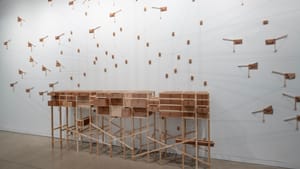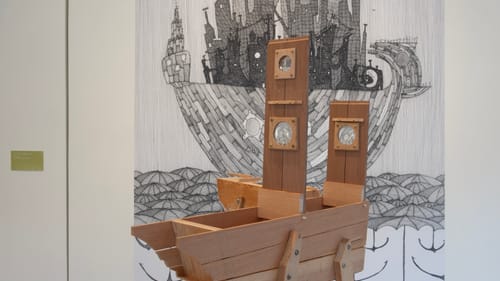Stay in the Loop
BSR publishes on a weekly schedule, with an email newsletter every Wednesday and Thursday morning. There’s no paywall, and subscribing is always free.
If wood could watch us
The Museum for Art in Wood presents The Longest Distance Between Two Points

It’s a giraffe, right? The figure stands sentry at the opening of woodworker/illustrator Katie Hudnall’s delightful, mind-bending exhibition, The Longest Distance Between Two Points, at the Museum for Art in Wood.
Like other three-dimensional pieces in the show, this one is fashioned of salvaged wood, string, springs, and hardware. It has a long, thin arc of a neck and a delicate isosceles of a face. It stands on three balletic legs, as if dancing on point.
And it’s not alone. Overhead track lights cast the creature’s silhouette multiple times on the white wall behind it, evoking a shadowy herd.
The placard calls it The Let Goer and explains that the structure is designed to hold (where the “giraffe’s” mouth would be) the winged seed of a deciduous tree, then release that seed so it can gently helicopter to the ground.
Furniture lives
But your zoomorphic thoughts aren’t off-base, because in Hudnall’s ingenious imagination, furniture is a little bit alive, ships ride on umbrella seas, and drawers open to reveal practical and idiosyncratic treasures: a rusted wrench, a numeral 4 made of metal, a salvaged stick.
It’s a world that is mechanical, playful, and slightly impossible: drawings and wood constructions that evoke the contraptions of Rube Goldberg, the fractured perspectives of M.C. Escher, and the illustrations of Edward Gorey.
Near The Let Goer is a gathering of six more wooden creatures titled The Herd. (See what I mean about the zoomorphism?) These have spindly, jointed legs and heads that resemble boats with convex, porthole “eyes.” Two of them stand in close communion, near enough to breathe each other’s woodsy breath, while one is poised on the margins of the group, as if an outcast (or perhaps iconoclast) among its kin.
Illustrator and woodworker
Hudnall lives in Madison, Wisconsin, and runs the woodworking and furniture program at the University of Wisconsin; according to her bio, she “spends her time making tools for problems both real and imagined.”
She considers herself an illustrator first and a woodworker second. That’s clear in her versatile use of lines—cross-hatching, patterning, capturing energy and movement in a spoke or a swoop.
Longest Distance includes several of her drawings, originally made on paper not much larger than a sheet of typescript, now super-sized to six by 10 feet or bigger on Phototex, a self-adhesive polyester fabric.
City Boat on an Umbrella Sea is an illustration of a boat—the kind that might inhabit a children’s picture book—bobbing on a sea made of umbrellas, their handles forked like anchors; her lines variously evoke city grit, wood striations, and falling rain.

The cheekily titled A Flight depicts a narrow, steep staircase on wheels—a portable ascent to anywhere or nowhere. And in Schematic 1, near a stray ink-mark in the lower left corner, Hudnall has scrawled a caption: “I dropped my pen.”
Some pieces combine illustration and woodworking. Symbiosis #4: Drawings and Drawers consists of six wooden drawers, each half-open and holding a mechanical part, tagged as if it were a lab specimen. On the other side of the sculpture are six drawings: one called Anatomy of a Snork Box, another labeled A Mobile, Collapsible Night Light (highly functional).
In Night Light, an enlarged portion of the drawing notes, “Flip the wheel thingumy to get her to roll.”
Deft and refreshing
A refreshing lack of self-seriousness pervades this exhibit, even while it’s clear that Hudnall has a deft command of mechanics and assemblage, balance, and weight. The three-dimensional pieces are designed to move; in A Half-Month’s Worth, tugging a drawer activates a pulley that opens a drawing of the moon in one of its phases.
Alas, viewers can’t see these moons unfurling. The gallery is peppered with reminder signs—“touching harms the art”—and it’s clear to see that the slender wood and filaments of string wouldn’t withstand repeated use.
Still, it’s tempting to touch these sculptures, with their buffed-wood surfaces and Tinkertoy-like designs. In the exhibit’s signature piece, A Cabinet for Lost and Found Things, Hudnall references the “cabinets of curiosities” dating from Renaissance Europe that displayed their owners’ collections of historic, scientific, or artistic objects.
In Hudnall’s monumental version, there are 43 wooden drawers, each tethered by cord and pulleys to a flat, hinged paddle on the wall, like what the optometrist gives you to cover one eye during a vision test. Pull on a drawer—or rather, don’t, but imagine pulling it—and the corresponding paddle swings aside to reveal a carved eye underneath.
Wondering what lies inside those drawers? Hudnall quenches our curiosity a bit by leaving a few open: one holds a wrench bearing a patina of rust; another has mismatched earrings, their mates long gone. In a third are two of the scalloped foam toe-separators used at nail salons. One drawer holds three chestnuts.
The work is at once simple and intricate, revealing and mysterious. It asks: what do we value enough to save? What are we missing? To whom are these objects important? What will I leave behind?
Wonder and wander
In this artist’s strange and whimsical world, we’re invited to wonder and wander, to imagine furniture having a social life or a stick being cherished enough to keep in a drawer. Eyes—illustrated and carved, in a glass oculus or the whorled grain of reclaimed wood—are ubiquitous in Hudnall’s work. Look, she seems to be saying, then look again. We think we’re gazing at ordinary objects only to find that they may, in fact, be watching us.
What, When, Where
The Longest Distance Between Two Points. Through July 20, 2025, at the Museum for Art in Wood, 141 N 3rd Street, Philadelphia. (215) 923-8000 or museumforartinwood.org.
Accessibility
The Museum for Art in Wood is a wheelchair-accessible venue.
Sign up for our newsletter
All of the week's new articles, all in one place. Sign up for the free weekly BSR newsletters, and don't miss a conversation.
 Anndee Hochman
Anndee Hochman